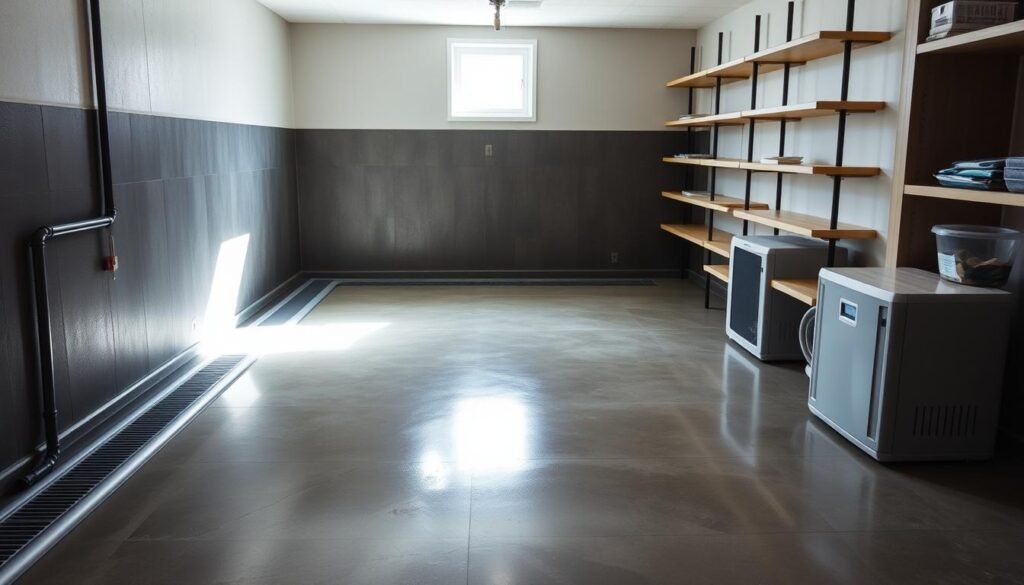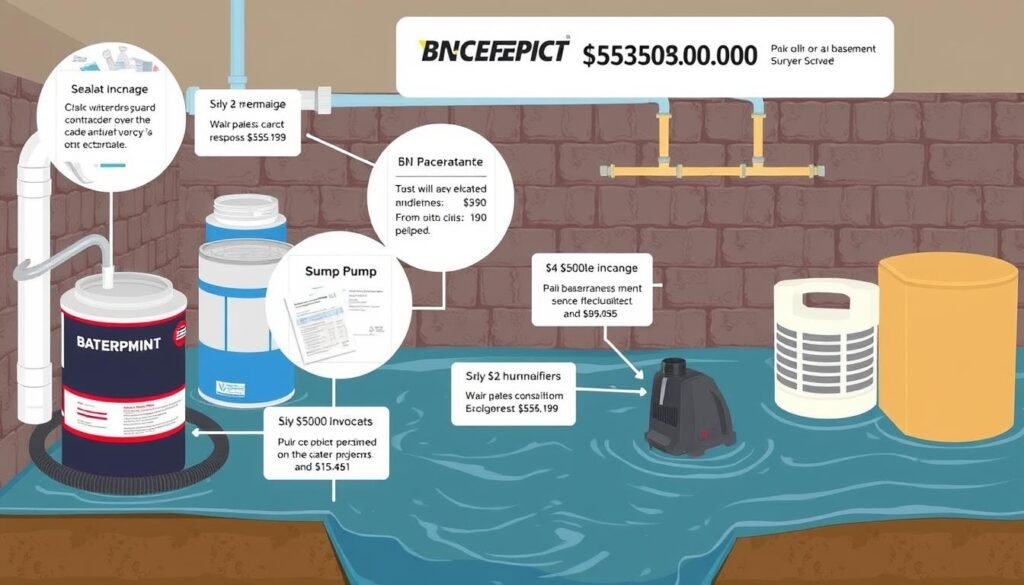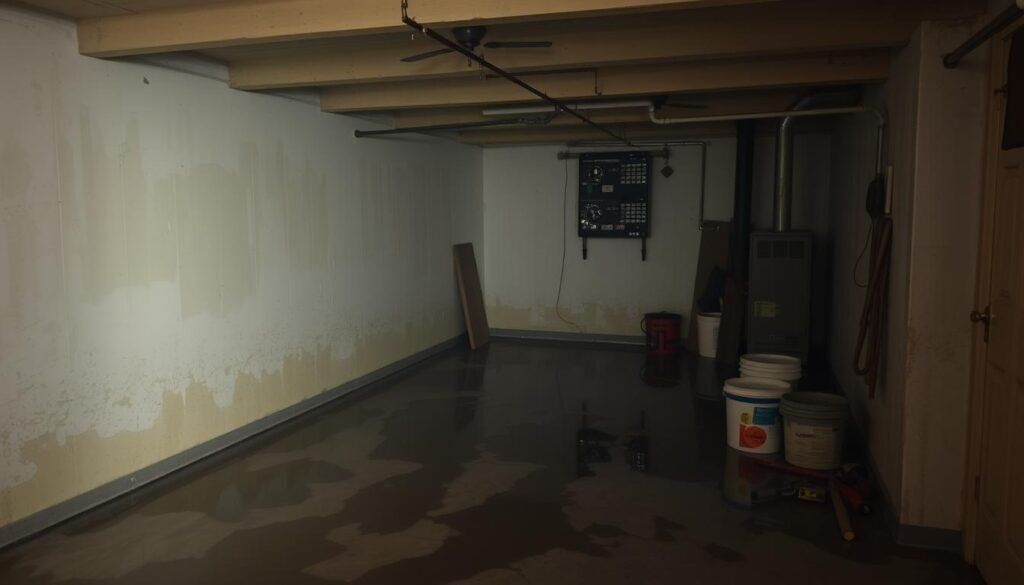Water in basements can cause major problems for homeowners. It leads to musty odors, mold growth, and damaged walls and floors. Quick action is vital to prevent further damage and protect your home’s structure.
Finding the moisture source is key to solving basement water issues. This could be condensation, surface runoff, or subsurface seepage. Understanding the cause helps create an effective plan for a dry basement.
With expert guidance, you can overcome these challenges. You’ll be able to enjoy a dry, comfortable, and healthy living space in your home.
Table of Contents
ToggleKey Takeaways
- Identify the source of moisture to address the root cause of water in the basement
- Implement a combination of quick fixes and long-term solutions to keep your basement dry
- Explore professional waterproofing services for comprehensive and lasting solutions
- Maintain your basement and surrounding area to prevent future water intrusion
- Act promptly to prevent further damage and health issues caused by a wet basement
Signs of a Wet Basement
Spotting early signs of basement moisture is key to fixing issues before they worsen. Look out for these common indicators of wet basements:
Visible Water or Dampness
Water stains on walls or floors signal moisture seeping into your basement. Standing water and damp areas can lead to water damage. These signs also increase the risk of mold growth.
Musty Odors and Mold Growth
A musty smell often means moisture buildup in your basement. This can lead to visible mold or mildew. Mold thrives in damp spaces and may cause health issues if ignored.
Efflorescence and Peeling Paint
White, powdery deposits on concrete surfaces indicate moisture movement through basement walls. Peeling or flaking paint may also point to underlying moisture problems.
Quick action on these signs can prevent further damage to your basement. Identifying the root cause is crucial for effective solutions.
By addressing issues promptly, you’ll maintain a healthy, dry living space. This proactive approach keeps your basement protected from moisture-related problems.
Identifying the Source of Moisture
Basements often attract moisture. Finding the exact source is key to fixing the problem. The main culprits are condensation, surface runoff, and subsurface seepage.
Condensation
Condensation happens when warm air meets cool surfaces. This creates water droplets. It can occur when humid air enters through windows or vents.
Moisture from activities like showering or laundry can also cause condensation. Proper ventilation is crucial to prevent this issue.
Surface Runoff
Surface runoff comes from rainwater or melted snow. It’s a problem when water isn’t directed away from the home’s foundation.
If the ground slopes towards the basement, water can seep in. Clogged gutters and downspouts can make this worse.
Subsurface Seepage
Subsurface seepage occurs when groundwater pushes into the basement. This can happen due to high water tables or underground springs.
Poor foundation waterproofing can lead to this issue. Cracks in basement walls or floors can also let moisture in.
Correctly identifying the moisture source is vital. This helps choose the right solution to keep your basement dry.
“Basements are notoriously dark and damp places, making moisture a common problem with significant consequences for homeowners.”
Quick Fixes for a Wet Basement
Wet basements can be frustrating, but quick fixes can provide immediate relief. These temporary measures help dry out the space and prevent further damage. They buy time while you address the root cause of moisture problems.
Increasing Air Circulation
Improve air circulation to tackle a wet basement. Set up high-powered fans to boost air movement and promote evaporation. This simple step helps dry the area and stops mold growth.
Removing Standing Water
Remove standing water in your basement immediately. Use a wet/dry vacuum or submersible pump to extract excess water. Dispose of the water away from the foundation to prevent seepage.
Reducing Humidity Levels
High humidity contributes to a damp basement environment. Get a dehumidifier to remove moisture from the air. This creates a drier space and makes it less friendly for mold.
These quick fixes are temporary solutions. To truly fix a wet basement, identify and address the underlying causes. Look for poor drainage, foundation cracks, or water seepage.
With the right long-term solutions, you can keep your basement dry. This prevents future moisture-related problems and ensures a healthier living space.
Long-Term Solutions for a Dry Basement
A dry basement needs a thorough, long-lasting approach. Focus on improving drainage, sealing cracks, and waterproofing walls. Install a reliable sump pump system to prevent water intrusion.
Improving Drainage Around the Home
Good drainage keeps water away from your foundation. Ensure gutters and downspouts direct water at least 4 feet from your home. Slope the soil around the foundation away from the house.
Consider installing a French drain system to manage excess groundwater. These steps will help stop water from seeping into your basement.
Sealing Cracks and Waterproofing Walls
Check your basement walls and floor for cracks or gaps. Seal them with hydraulic cement or polyurethane caulk. Apply a waterproof coating to the walls for extra protection.
These solutions will create a strong barrier against moisture intrusion. They’ll help keep your living space dry and comfortable.
Installing a Sump Pump System
A well-sized sump pump can transform a wet basement. It removes groundwater constantly, preventing flooding. Maintain your pump regularly by testing it and clearing debris.
These long-term fixes address the root causes of basement moisture. They create a healthier living environment for your family. Tackling water issues is an investment in your home’s long-term basement waterproofing.

DIY Waterproofing Options
DIY basement waterproofing can be effective for handy homeowners. Applying waterproof coatings like UGL’s DryLok Waterproofer directly to walls can seal cracks. This helps prevent water from seeping into your basement.
Improving ventilation is another crucial DIY step. Good air circulation reduces humidity and prevents condensation. This, in turn, helps avoid mold and mildew growth in your basement.
Add exhaust fans, foundation vents, or use window fans to boost air flow. Dehumidifiers can also help control moisture levels in your basement space.
Waterproof Coatings
DryLok Waterproofer and similar products offer affordable DIY basement protection. These coatings create a barrier against water on your walls. A DIY waterproofing kit costs about $6 per square foot on average.
Ventilation System Upgrades
Better ventilation is key to a dry basement. Install exhaust fans or foundation vents to improve air circulation. Window fans and dehumidifiers can also help reduce humidity levels.
These upgrades can effectively address moisture issues without major construction work. They’re often simple enough for homeowners to handle themselves.
| DIY Waterproofing Solution | Average Cost | Key Benefits |
|---|---|---|
| Waterproof Coatings | $6 per square foot |
|
| Ventilation System Upgrades | Varies |
|
These DIY waterproofing options empower homeowners to tackle basement moisture issues. By taking action, you can create a drier, healthier living space in your home.
Professional Waterproofing Services
Severe basement moisture issues often require professional waterproofing services. Experts have the skills and tools to diagnose root causes. They implement long-lasting solutions that surpass DIY methods.
Interior Waterproofing
Interior waterproofing involves installing a drainage system along the basement floor’s perimeter. This system collects water and channels it to a sump pump. Professionals use specialized equipment to ensure proper installation and function.
Exterior Waterproofing
Exterior waterproofing requires excavation around the foundation. Contractors apply a waterproof membrane and install an external drainage system. This approach addresses water intrusion from the ground up.
French Drain Installation
French drains are underground perimeter systems that divert groundwater away from foundations. They reduce the risk of water entering basements. Professionals design and install these systems based on your property’s needs.
| Waterproofing Service | Average Cost |
|---|---|
| Interior Waterproofing | $3,000 – $7,000 |
| Exterior Waterproofing | $5,000 – $10,000 |
| French Drain Installation | $2,000 – $6,000 |
Professional basement waterproofing services may require a higher initial investment. However, the benefits of a dry basement often outweigh the costs. Experienced contractors provide custom solutions for your home’s unique challenges.
Maintaining a Dry Basement
A dry basement requires ongoing effort and the right strategies. Regular inspections and proactive steps are crucial. These measures ensure a healthy, comfortable living space.
Regular Maintenance Tips
Inspect and clean your home’s gutters and downspouts often. Make sure they direct water away from the foundation. This prevents water buildup around the basement.
Check for new foundation cracks and seal them quickly. This stops water from seeping in. Test your sump pump system regularly.
The American Society of Home Inspectors reports a startling statistic. “60 percent of US homes have wet basements,” often due to faulty sump pumps. Replace your pump if needed.
Monitor basement humidity levels to prevent mold growth. Use a dehumidifier or exhaust fan to maintain optimal moisture levels. This stops condensation on cold surfaces like pipes.
Landscaping Considerations
Your home’s landscaping affects basement moisture levels. Ensure the ground slopes away from the foundation. This directs water runoff away from the basement.
Avoid planting water-hungry plants near the foundation. Their roots can cause cracks and water seepage. Insulate exterior walls and rim joists in the basement.
Proper insulation reduces condensation and regulates temperature. This contributes to a dry basement environment. Follow these tips to protect your home from moisture damage.
water in basement: Costs and Considerations
Wet basements can be challenging and expensive to fix. Understanding the options and costs is vital for homeowners. Basement waterproofing expenses vary based on problem severity and chosen solutions.
Waterproofing a 1,000-square-foot basement typically costs between $3,000 and $10,000. Professional services usually charge $3 to $10 per square foot. These prices can help homeowners budget for their project.
| Basement Size | Low-End Cost | High-End Cost |
|---|---|---|
| 500 sq ft | $1,500 | $5,000 |
| 750 sq ft | $2,250 | $7,500 |
| 1,000 sq ft | $3,000 | $10,000 |
| 1,250 sq ft | $3,750 | $12,500 |
| 1,500 sq ft | $4,500 | $15,000 |
| 2,000 sq ft | $6,000 | $20,000 |
Homeowners should weigh their budget against long-term benefits of permanent basement waterproofing. This protects the home’s foundation and living space. DIY options like waterproof coatings are cheaper but less effective.
Professional services such as interior or exterior waterproofing offer lasting solutions. These methods prevent future water damage and maintain structural integrity. The investment can pay off in the long run.

Additional costs may include mold and asbestos removal, water damage repair, and foundation fixes. These factors can significantly increase overall project expenses. A thorough assessment and planning process is crucial for accurate budgeting.
Conclusion
Water in the basement needs a thorough approach for a dry, healthy home. Recognizing signs, finding causes, and using quick fixes and long-term solutions are key. Homeowners can tackle issues themselves or hire professionals to protect their property’s structure and value.
A multi-faceted strategy is often needed to address summary of basement water solutions. This includes improving drainage, sealing cracks, installing sump pumps, and upgrading ventilation. Staying alert and maintaining water management systems can prevent costly damage.
Homeowners can take control of basement water issues with the right knowledge. Understanding causes, exploring remedies, and seeking help when needed leads to effective summary of basement water solutions. This results in a dry, healthy basement environment.
FAQ
What are the signs of a wet basement?
Wet basements show visible water or dampness on walls and floors. You may notice musty odors, mold growth, or white mineral deposits. Peeling paint or wallpaper are also common signs.
What are the main causes of water in the basement?
Condensation occurs when warm air meets cool surfaces, creating water droplets. Surface runoff happens when rainwater isn’t directed away from the foundation. Subsurface seepage is when groundwater pushes into the basement from below.
What are some quick fixes for a wet basement?
Set up fans to increase air circulation and remove standing water. Use a wet/dry vacuum or pump to clear excess moisture. A dehumidifier can help reduce humidity levels in the space.
What are some long-term solutions for a dry basement?
Improve drainage around your home and seal foundation cracks. Install a sump pump system to manage excess water. Direct gutters and downspouts away from the foundation.
Grade the soil to slope away from the house. Apply waterproof coating to walls after sealing cracks with hydraulic cement or polyurethane caulk.
What are some DIY waterproofing options for the basement?
Apply waterproof coatings like UGL’s DryLok Waterproofer to the walls. Upgrade the ventilation system to reduce humidity and prevent condensation. Add exhaust fans, foundation vents, and use window fans or dehumidifiers for better air circulation.
When should I consider professional waterproofing services?
Severe or persistent moisture problems may require professional waterproofing services. Interior waterproofing involves installing a drainage system along the basement floor perimeter. Exterior waterproofing requires excavation to apply a waterproof membrane and install drainage.
A French drain system can effectively divert groundwater away from the home’s foundation.
How can I maintain a dry basement?
Regularly inspect and clean gutters and downspouts. Check for and seal new foundation cracks. Test the sump pump system and monitor humidity levels.
Keep basement windows closed during humid weather. Maintain proper landscaping with a positive grade away from the foundation.
How much does basement waterproofing cost?
Basement waterproofing costs vary based on the problem’s severity and chosen solution. DIY options like waterproof coatings are relatively inexpensive. Professional services such as interior or exterior waterproofing can be more costly.
Consider your budget and the long-term benefits of a permanent solution. Protecting your home’s foundation and living space is a worthwhile investment.

